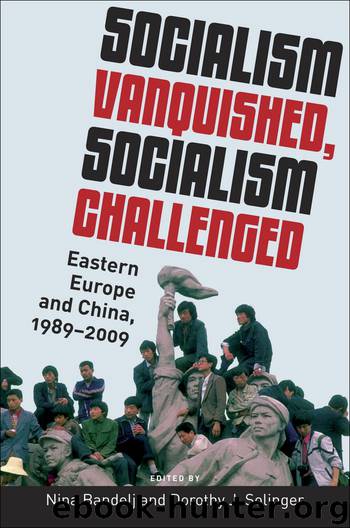Socialism Vanquished, Socialism Challenged by Bandelj Nina; Solinger Dorothy J.;

Author:Bandelj, Nina; Solinger, Dorothy J.;
Language: eng
Format: epub
Publisher: Oxford University Press, Incorporated
Published: 2012-01-01T16:00:00+00:00
Notes
The first version of this chapter was prepared for presentation at the 1989 Anniversary Conference, organized by Nina Bandelj and Dorothy Solinger, at the University of California at Irvine, November 6–8, 2009.
Data used in this study have been accessed electronically through Rutgers University’s Alexander Library. The original, conference version of this paper was prepared while I benefited from two residential fellowships: one at Collegium Budapest/Institute for Advanced Studies, the other at the Jawaharlal Nehru Institute of Advanced Study at the Jawaharlal Nehru University, New Delhi, India, and it received its final touches while I held fellowships at the Zentrum für Höhere Studien and the Geisteswissenschaftliches Zentrum für die Geschichte und Kultur Osteuropas, both at the University of Leipzig, Germany. Financial support from Collegium Budapest, JNIAS, and the University of Leipzig are gratefully acknowledged. I am truly grateful to Mahua Sarkar for her encouragement, comments, and criticisms.
1. In order to avoid the Cold War-inflected convention of reifying these geographical areas as internally homogenous, externally distinct “regions,” I do not capitalize the adjectives that point at them. By “northern Eurasia,” I refer to the successor states of the former USSR; “eastern Europe” includes the reminder of former state socialist societies in Europe.
2. Of the many, valuable approaches to understanding the history of neoliberal hegemony, let me quote here the most relevant one, which puts it squarely in the center of an analytical framework developed in the context of the suprastate project of the European Union: van Apeldoorn et al., 2003, especially pp. 37–39.
3. See Böröcz 2010, especially the chapter titled “Global Economic Weight in the Longue-Durée: Nemesis of West European Geopolitics.”
4. No doubt, there is a large number of important dimensions along which this transformation could and should be analyzed, so that these two represent—in my mind, very important, but still—a partial subset of the relevant “angles.”
5. By geopolitics, I mean simply the ways in which organizations project their power into the world outside their borders.
6. For more on the implications of this two-dimensional view of the global trajectories of states, see Böröcz 2010, especially the chapter titled “Global Economic Weight in the Longue-Durée: Nemesis of West European Geopolitics.”
7. Maddison’s data set provides estimates for economic performance and population for more than 2,000 years of world history.
8. Geary-Khamis USD. For more detail on the estimation procedure, see Maddison 2006a, 2006b.
9. This section, explaining the logic of the presentation of the empirical data, follows closely the way in which the technique is introduced in Böröcz 2010. For more detail, please consult the chapter titled “Global Economic Weight in the Longue-Durée: Nemesis of West European Geopolitics.”
10. Ibid.
11. Maddison’s data set does not provide estimates for CMEA, the EU, the Warsaw Pact or NATO; these figures were produced by summing up the global economic weight (measured as percentage share in the gross world product) of their member states and by computing the unweighted mean of their per capita GDP (expressed as percentages of the world average). The CMEA figures have been computed by summing up
Download
This site does not store any files on its server. We only index and link to content provided by other sites. Please contact the content providers to delete copyright contents if any and email us, we'll remove relevant links or contents immediately.
American Kingpin by Nick Bilton(3510)
Future Crimes by Marc Goodman(3374)
The Meaning of the Library by unknow(2388)
Inside the Middle East by Avi Melamed(2233)
Why Nations Fail: The Origins of Power, Prosperity, and Poverty by Daron Acemoglu & James Robinson(2177)
On Tyranny by Timothy Snyder(2130)
Living Silence in Burma by Christina Fink(1984)
Putin's Labyrinth(1902)
The Mastermind by Evan Ratliff(1830)
The Smartest Kids in the World by Amanda Ripley(1686)
Think Like a Rocket Scientist by Ozan Varol(1678)
Law: A Very Short Introduction by Raymond Wacks(1636)
The Rule of Law by Bingham Tom(1594)
It's Our Turn to Eat by Michela Wrong(1593)
Leadership by Doris Kearns Goodwin(1564)
A Dirty War by Anna Politkovskaya(1543)
Philosophy of law a very short introduction by Raymond Wacks(1542)
Social Media Law in a Nutshell by Ryan Garcia & Thaddeus A Hoffmeister(1451)
Civil Procedure (Aspen Casebooks) by Stephen C. Yeazell(1440)
